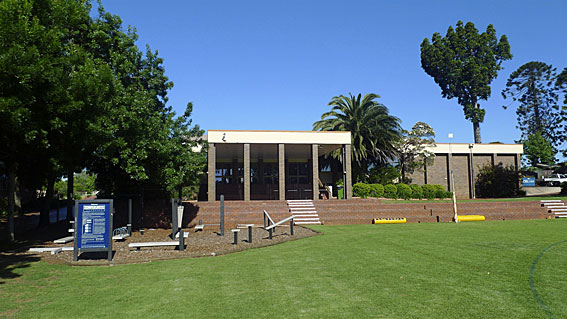
The Assembly Hall, Fairholme College
[Photograph by Trevor Bunning (November 2011)]

The Assembly Hall, Fairholme College
[Photograph by Trevor Bunning (November 2011)]
Historical and Technical Documentation by Geoffrey Cox
© OHTA 2011 (last updated November 2011)
Fairholme College has existed on its present site since 1917, having originated from the earlier Spreyton College, which was opened in the Newtown area of Toowoomba in 1908. For many years the College was officially named the 'Presbyterian Girls' College', but the name 'Fairholme' (by which it had always been known) was legally adopted in 1978.1
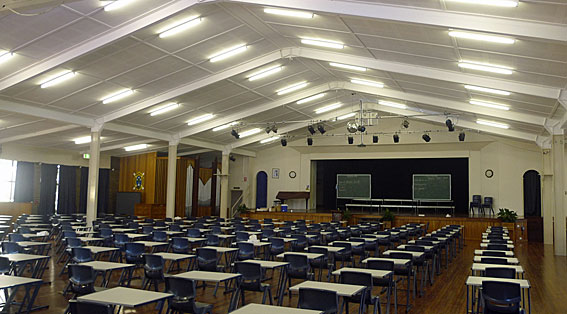
The organ in the Assembly Hall, Fairholme College, Toowoomba
[Photograph by Trevor Bunning (November 2011)]
The organ in the Assembly Hall was acquired by the College in the mid 1990s. The instrument dates in its present form essentially from 1968, although some of the pipework originates from a residence organ built in 1886 by the English firm Hele & Co. of Plymouth. This instrument was built for Robert H.D. White, M.L.A. (1838-1900) and installed in his residence 'Tahlee House' at Port Stephens on the coast of the Hunter Region of New South Wales.2 It was one of three instruments supplied by the firm for Australia in the 1880s. The completion of White's organ was noted in Plymouth in 1886 as follows:
Messrs Hele and Company, organ builders, recently received an order for a saloon organ from Mr R. H. D. White, M.P., one of the Commissioners for Australia. The instrument is now completed and is being exhibited at their manufactory. The tone of the organ is exactly suited to the purpose for which it is intended, the greatest power being obtained by means of couplers, etc, with the smallest number of stops. The quality of the soft stops in the choir and swell organs, and especially of the dulciana and celeste, is very good; and, indeed, the organ, as a whole, is balanced with that care and nicety which are the distinguishing mark of good workmanship. On Saturday afternoon last the instrument was formally opened in the presence of a large number of professional gentlemen and others by Mr John Hele, Mus. Bac., borough organist. The programme, which was played in a masterly and tasteful manner, and received with much appreciation by the audience, included Bach's well known Toccata and Fugue in D, a selection from Carmen (Bizet), and an Allegro by Lemmens. Mr Hele also played an Andante in D by Silas, which showed off the softer stops of the organ to great advantage, and finely displayed its full power in the Concerto in B flat (Handel).3
White is reported to have entertained W.T. Best at Port Stephens during his visit to Australia to open the organ in the Sydney Town Hall in 1890, and Best undoubtedly played the Hele organ during this visit. The instrument remained at Port Stephens until 1931, when it was purchased for £400 by St Philip's Anglican Church at Eastwood in Sydney, and erected there by Charles Leggo.4 The specification remained unaltered up to the 1960s and was recorded as follows:
| GREAT Open Diapason Flauto Principal Piccolo SWELL Gedact Gamba [Ten.C] Voix Celeste Gemshorn Oboe CHOIR Gedact Dulciana Lieblich Flote PEDAL Bourdon Bass Flute COUPLERS Swell to Great Swell to Great Octave Swell to Great Sub Swell to Pedal Great to Pedal Swell to Choir |
8 8 4 2 8 8 8 4 8 8 8 4 16 8 |
A A |
Mechanical action
Attached draw-stop console
Compass: 58/30
Parallel flat pedalboard.5
The organ survived more than 80 years without significant alteration, and is recalled as having possessed a most reliable and well designed mechanical action in the 1960s. The Swell and Choir shared a common windchest, and the instrument was built mostly of red mahogany.6 There is no foundation to the rumour that some of the pipework originated from Chichester Cathedral and was made by Renatus Harris.7
The Hele & Co. organ was effectively destroyed in 1968, when its pipework was incorporated into a new instrument by S.T. Noad & Son of Sydney at St Philip's, Eastwood, comprising 26 stops, 11 couplers and electro-pneumatic action.8 The original action, soundboards and casework (of two towers and a central flat with diapered pipes) were discarded at this time, despite attempts by Noad to have the structure of the instrument preserved elsewhere with new pipework. It is a paradox that the original Swell/Choir chest eventually found its way into a house organ in New South Wales where it is reported still to serve reliably.9
The Noad instrument was purchased by Fairholme College and removed to storage at the College in January 1995. It was erected in the Assembly Hall in January 1997 by Ian D. Brown & Associates of Ballina, and opened with a recital by Phillip Gearing on 13 April that year. Financial constraints ensured that only minimal work could be done on the instrument at the time, although it was supplied with a new solid-state note and coupler switching system, new Peterson electric swell engines, and new casework in keeping with the design of the hall.10
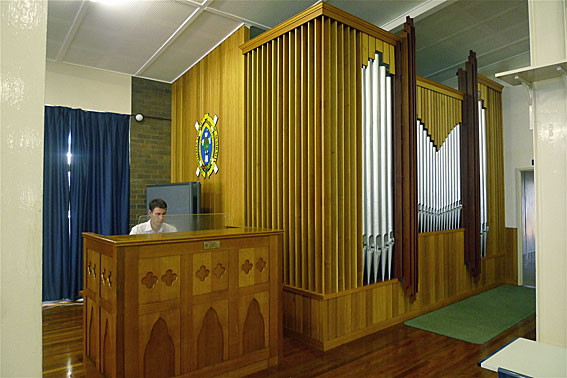
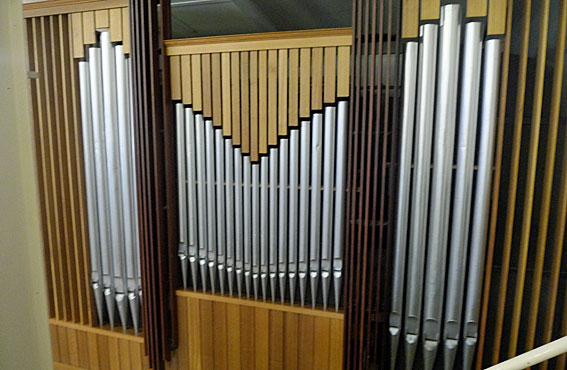
New casework supplied in 1997 by Ian D. Brown & Associates of Ballina
[Photographs by Trevor Bunning (November 2011)]
Further work on the instrument was undertaken early in 2003 by Ian D. Brown & Associates. This included the fitting of metal canisters to replace cork stoppers on the Choir Gedact 8ft and Flute 4ft and the Swell Gedact 8ft, repairs to the Pedal Bourdon 16ft, and increasing the wind pressure on the Pedal Sub Bass 16ft. At the same time, the tonal balance was adjusted by swapping the pipes of the Great Twelfth 2-2/3ft (a Principal-scale stop dating from 1968) with those of the original Swell Gemshorn 4ft (in reality a Salicet dating from the 1886 organ).11
The organ has been re-dedicated to the memory of Mr Bob Balsillie, organist and music teacher of Fairholme College, who had died prematurely of leukemia, and who had been the moving force in obtaining the organ for the College in the first instance.
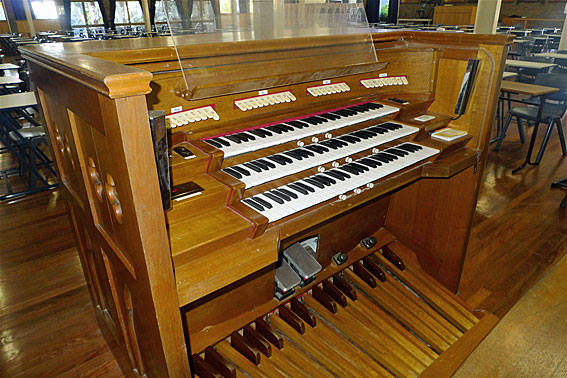
Console of the organ, supplied by S.T. Noad & Son in 1968
[Photograph by Trevor Bunning (November 2011)]
Stops assumed to date from the Hele organ are marked [1886] in the specification below:
| GREAT Open Diapason Flauto Principal Twelfth Fifteenth SWELL Gedact Gamba Gemshorn Flute Mixture Horn Oboe CHOIR (enclosed) Gedact Viol d'Orchestre Dulciana Lieblich Flute Nazard Piccolo Flautino PEDAL Sub Bass Bourdon Quint Principal Bass Flute Octave Flute COUPLERS Great to Pedal Swell to Pedal Choir to Pedal Swell to Great Swell to Choir Choir to Great Pedal Octave Great Octave Swell Octave Swell Sub Choir Octave |
8 8 4 2-2/3 2 8 8 4 4 III 8 8 8 8 8 4 2-2/3 2 1 16 16 10-2/3 8 8 4 4 |
A B D D C C C B B A B A B |
[1886] [1886] [1886] [1886; on Swell until 2003] [1886] [1886] [on Great until 2003] [1886] [1886] [1886] [1886] [1886] [1886] [1886] |
Swell tremulant
Electro-pneumatic action
Detached console
Compass: 61/32
Swell to Great reversible piston
Great to Pedal reversible piston
3 thumb pistons to Great
3 thumb pistons to Swell
3 thumb pistons to Choir
Balanced Swell pedal
Balanced Choir pedal.12
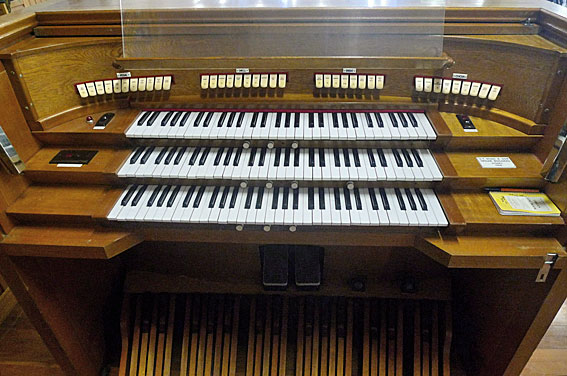
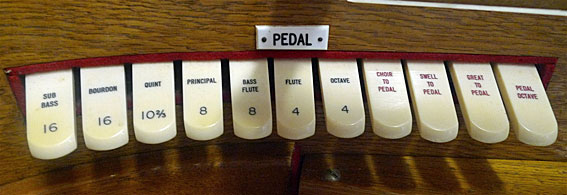
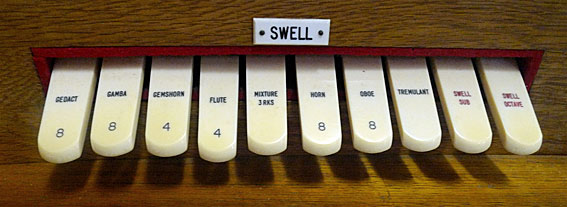
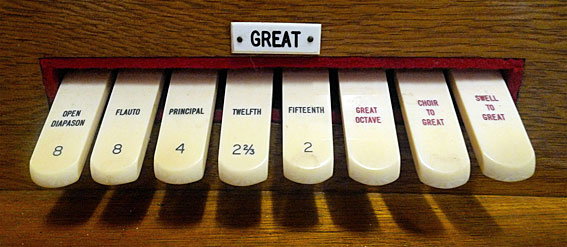
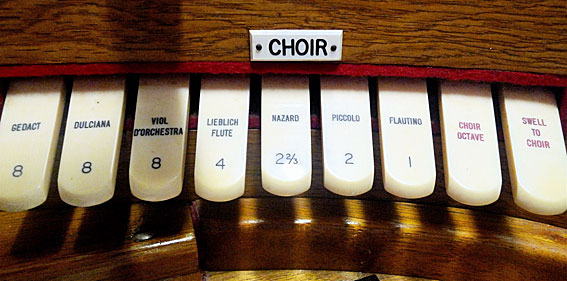
Console details
[Photographs by Trevor Bunning (November 2011)]
______________________________________________________________________
1 John Moore, Fairholme: The first 75 Years, 1917-1992 (Toowoomba, c.1992).
2 Graeme Rushworth, Historic Organs of New South Wales: The Instruments, Their Makers and Players 1791-1940 (Sydney: Hale & Iremonger, 1988), pp. 261-63; see also: G. Rushworth, 'Hele & Company of Plymouth - their three organs for New South Wales', The Sydney Organ Journal, vol. 10, no. 6 (December 1979/January 1980), pp. 17-23.
3 The Musical Standard (14 Aug 1886), p. 107, cited in Rushworth, pp. 262-63.
4 Rushworth, p. 263.
5 Specification noted by David Kinsela, May 1960, cited in Rushworth, p. 262.
6 Ian Brown, 'First Three-manual Pipe Organ for Toowoomba,' The Organ Voice, vol. 23, no. 2 (June 1997), pp. 21-28.
7 Rushworth, p. 263; Brown, p. 22.
8 Rushworth, p. 263.
9 Brown, pp. 22-23.
10 Brown, pp. 21, 25-26.
11 The Sydney Organ Journal, vol. 34, no. 2 (Autumn 2003), p. 37; The Organ Voice, vol. 29, no. 1 (March 2003), p. 23.
12 Specification based on Brown, op. cit., pp. 24-27, and details supplied by Robert Wallace to John Maidment, January 1971; with corrections and clarifications by Phillip Gearing and Ian Brown, 2003.